Input interpretation

Cl_2 chlorine + KOH potassium hydroxide + HBr hydrogen bromide ⟶ H_2O water + KCl potassium chloride + KBrO_3 potassium bromate
Balanced equation
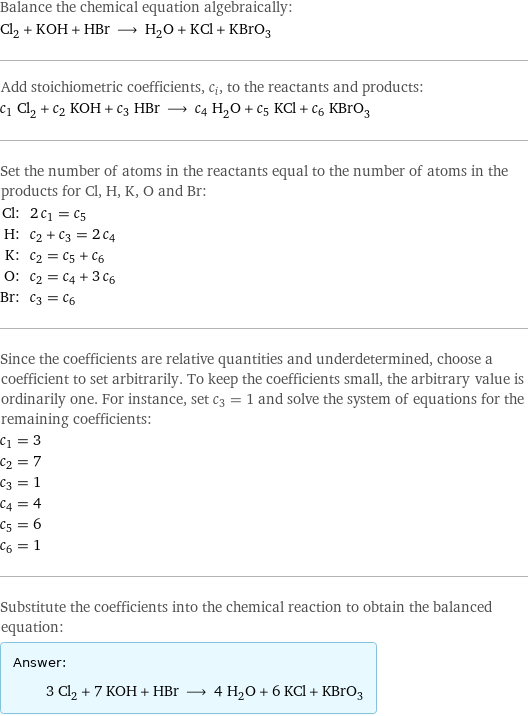
Balance the chemical equation algebraically: Cl_2 + KOH + HBr ⟶ H_2O + KCl + KBrO_3 Add stoichiometric coefficients, c_i, to the reactants and products: c_1 Cl_2 + c_2 KOH + c_3 HBr ⟶ c_4 H_2O + c_5 KCl + c_6 KBrO_3 Set the number of atoms in the reactants equal to the number of atoms in the products for Cl, H, K, O and Br: Cl: | 2 c_1 = c_5 H: | c_2 + c_3 = 2 c_4 K: | c_2 = c_5 + c_6 O: | c_2 = c_4 + 3 c_6 Br: | c_3 = c_6 Since the coefficients are relative quantities and underdetermined, choose a coefficient to set arbitrarily. To keep the coefficients small, the arbitrary value is ordinarily one. For instance, set c_3 = 1 and solve the system of equations for the remaining coefficients: c_1 = 3 c_2 = 7 c_3 = 1 c_4 = 4 c_5 = 6 c_6 = 1 Substitute the coefficients into the chemical reaction to obtain the balanced equation: Answer: | | 3 Cl_2 + 7 KOH + HBr ⟶ 4 H_2O + 6 KCl + KBrO_3
Structures
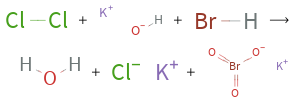
+ + ⟶ + +
Names

chlorine + potassium hydroxide + hydrogen bromide ⟶ water + potassium chloride + potassium bromate
Reaction thermodynamics
Enthalpy
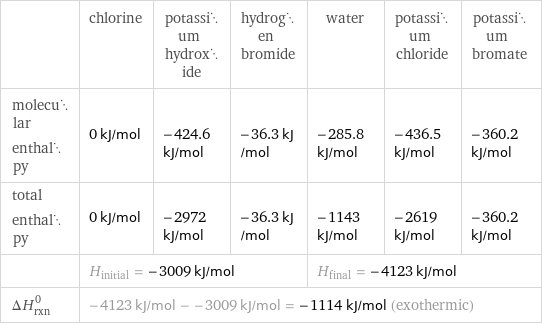
| chlorine | potassium hydroxide | hydrogen bromide | water | potassium chloride | potassium bromate molecular enthalpy | 0 kJ/mol | -424.6 kJ/mol | -36.3 kJ/mol | -285.8 kJ/mol | -436.5 kJ/mol | -360.2 kJ/mol total enthalpy | 0 kJ/mol | -2972 kJ/mol | -36.3 kJ/mol | -1143 kJ/mol | -2619 kJ/mol | -360.2 kJ/mol | H_initial = -3009 kJ/mol | | | H_final = -4123 kJ/mol | | ΔH_rxn^0 | -4123 kJ/mol - -3009 kJ/mol = -1114 kJ/mol (exothermic) | | | | |
Gibbs free energy
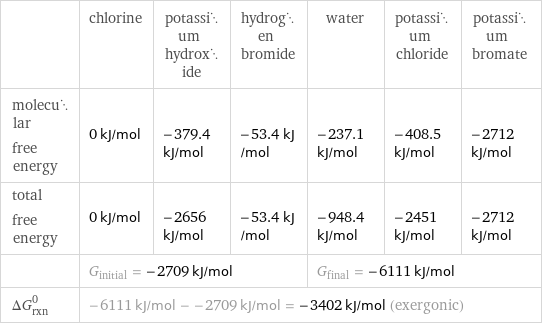
| chlorine | potassium hydroxide | hydrogen bromide | water | potassium chloride | potassium bromate molecular free energy | 0 kJ/mol | -379.4 kJ/mol | -53.4 kJ/mol | -237.1 kJ/mol | -408.5 kJ/mol | -2712 kJ/mol total free energy | 0 kJ/mol | -2656 kJ/mol | -53.4 kJ/mol | -948.4 kJ/mol | -2451 kJ/mol | -2712 kJ/mol | G_initial = -2709 kJ/mol | | | G_final = -6111 kJ/mol | | ΔG_rxn^0 | -6111 kJ/mol - -2709 kJ/mol = -3402 kJ/mol (exergonic) | | | | |
Equilibrium constant
![Construct the equilibrium constant, K, expression for: Cl_2 + KOH + HBr ⟶ H_2O + KCl + KBrO_3 Plan: • Balance the chemical equation. • Determine the stoichiometric numbers. • Assemble the activity expression for each chemical species. • Use the activity expressions to build the equilibrium constant expression. Write the balanced chemical equation: 3 Cl_2 + 7 KOH + HBr ⟶ 4 H_2O + 6 KCl + KBrO_3 Assign stoichiometric numbers, ν_i, using the stoichiometric coefficients, c_i, from the balanced chemical equation in the following manner: ν_i = -c_i for reactants and ν_i = c_i for products: chemical species | c_i | ν_i Cl_2 | 3 | -3 KOH | 7 | -7 HBr | 1 | -1 H_2O | 4 | 4 KCl | 6 | 6 KBrO_3 | 1 | 1 Assemble the activity expressions accounting for the state of matter and ν_i: chemical species | c_i | ν_i | activity expression Cl_2 | 3 | -3 | ([Cl2])^(-3) KOH | 7 | -7 | ([KOH])^(-7) HBr | 1 | -1 | ([HBr])^(-1) H_2O | 4 | 4 | ([H2O])^4 KCl | 6 | 6 | ([KCl])^6 KBrO_3 | 1 | 1 | [KBrO3] The equilibrium constant symbol in the concentration basis is: K_c Mulitply the activity expressions to arrive at the K_c expression: Answer: | | K_c = ([Cl2])^(-3) ([KOH])^(-7) ([HBr])^(-1) ([H2O])^4 ([KCl])^6 [KBrO3] = (([H2O])^4 ([KCl])^6 [KBrO3])/(([Cl2])^3 ([KOH])^7 [HBr])](../image_source/1288c50e4257b705e40a0a28f1a7c114.png)
Construct the equilibrium constant, K, expression for: Cl_2 + KOH + HBr ⟶ H_2O + KCl + KBrO_3 Plan: • Balance the chemical equation. • Determine the stoichiometric numbers. • Assemble the activity expression for each chemical species. • Use the activity expressions to build the equilibrium constant expression. Write the balanced chemical equation: 3 Cl_2 + 7 KOH + HBr ⟶ 4 H_2O + 6 KCl + KBrO_3 Assign stoichiometric numbers, ν_i, using the stoichiometric coefficients, c_i, from the balanced chemical equation in the following manner: ν_i = -c_i for reactants and ν_i = c_i for products: chemical species | c_i | ν_i Cl_2 | 3 | -3 KOH | 7 | -7 HBr | 1 | -1 H_2O | 4 | 4 KCl | 6 | 6 KBrO_3 | 1 | 1 Assemble the activity expressions accounting for the state of matter and ν_i: chemical species | c_i | ν_i | activity expression Cl_2 | 3 | -3 | ([Cl2])^(-3) KOH | 7 | -7 | ([KOH])^(-7) HBr | 1 | -1 | ([HBr])^(-1) H_2O | 4 | 4 | ([H2O])^4 KCl | 6 | 6 | ([KCl])^6 KBrO_3 | 1 | 1 | [KBrO3] The equilibrium constant symbol in the concentration basis is: K_c Mulitply the activity expressions to arrive at the K_c expression: Answer: | | K_c = ([Cl2])^(-3) ([KOH])^(-7) ([HBr])^(-1) ([H2O])^4 ([KCl])^6 [KBrO3] = (([H2O])^4 ([KCl])^6 [KBrO3])/(([Cl2])^3 ([KOH])^7 [HBr])
Rate of reaction
![Construct the rate of reaction expression for: Cl_2 + KOH + HBr ⟶ H_2O + KCl + KBrO_3 Plan: • Balance the chemical equation. • Determine the stoichiometric numbers. • Assemble the rate term for each chemical species. • Write the rate of reaction expression. Write the balanced chemical equation: 3 Cl_2 + 7 KOH + HBr ⟶ 4 H_2O + 6 KCl + KBrO_3 Assign stoichiometric numbers, ν_i, using the stoichiometric coefficients, c_i, from the balanced chemical equation in the following manner: ν_i = -c_i for reactants and ν_i = c_i for products: chemical species | c_i | ν_i Cl_2 | 3 | -3 KOH | 7 | -7 HBr | 1 | -1 H_2O | 4 | 4 KCl | 6 | 6 KBrO_3 | 1 | 1 The rate term for each chemical species, B_i, is 1/ν_i(Δ[B_i])/(Δt) where [B_i] is the amount concentration and t is time: chemical species | c_i | ν_i | rate term Cl_2 | 3 | -3 | -1/3 (Δ[Cl2])/(Δt) KOH | 7 | -7 | -1/7 (Δ[KOH])/(Δt) HBr | 1 | -1 | -(Δ[HBr])/(Δt) H_2O | 4 | 4 | 1/4 (Δ[H2O])/(Δt) KCl | 6 | 6 | 1/6 (Δ[KCl])/(Δt) KBrO_3 | 1 | 1 | (Δ[KBrO3])/(Δt) (for infinitesimal rate of change, replace Δ with d) Set the rate terms equal to each other to arrive at the rate expression: Answer: | | rate = -1/3 (Δ[Cl2])/(Δt) = -1/7 (Δ[KOH])/(Δt) = -(Δ[HBr])/(Δt) = 1/4 (Δ[H2O])/(Δt) = 1/6 (Δ[KCl])/(Δt) = (Δ[KBrO3])/(Δt) (assuming constant volume and no accumulation of intermediates or side products)](../image_source/3715a8e852a959dd02192c38f111c1e8.png)
Construct the rate of reaction expression for: Cl_2 + KOH + HBr ⟶ H_2O + KCl + KBrO_3 Plan: • Balance the chemical equation. • Determine the stoichiometric numbers. • Assemble the rate term for each chemical species. • Write the rate of reaction expression. Write the balanced chemical equation: 3 Cl_2 + 7 KOH + HBr ⟶ 4 H_2O + 6 KCl + KBrO_3 Assign stoichiometric numbers, ν_i, using the stoichiometric coefficients, c_i, from the balanced chemical equation in the following manner: ν_i = -c_i for reactants and ν_i = c_i for products: chemical species | c_i | ν_i Cl_2 | 3 | -3 KOH | 7 | -7 HBr | 1 | -1 H_2O | 4 | 4 KCl | 6 | 6 KBrO_3 | 1 | 1 The rate term for each chemical species, B_i, is 1/ν_i(Δ[B_i])/(Δt) where [B_i] is the amount concentration and t is time: chemical species | c_i | ν_i | rate term Cl_2 | 3 | -3 | -1/3 (Δ[Cl2])/(Δt) KOH | 7 | -7 | -1/7 (Δ[KOH])/(Δt) HBr | 1 | -1 | -(Δ[HBr])/(Δt) H_2O | 4 | 4 | 1/4 (Δ[H2O])/(Δt) KCl | 6 | 6 | 1/6 (Δ[KCl])/(Δt) KBrO_3 | 1 | 1 | (Δ[KBrO3])/(Δt) (for infinitesimal rate of change, replace Δ with d) Set the rate terms equal to each other to arrive at the rate expression: Answer: | | rate = -1/3 (Δ[Cl2])/(Δt) = -1/7 (Δ[KOH])/(Δt) = -(Δ[HBr])/(Δt) = 1/4 (Δ[H2O])/(Δt) = 1/6 (Δ[KCl])/(Δt) = (Δ[KBrO3])/(Δt) (assuming constant volume and no accumulation of intermediates or side products)
Chemical names and formulas
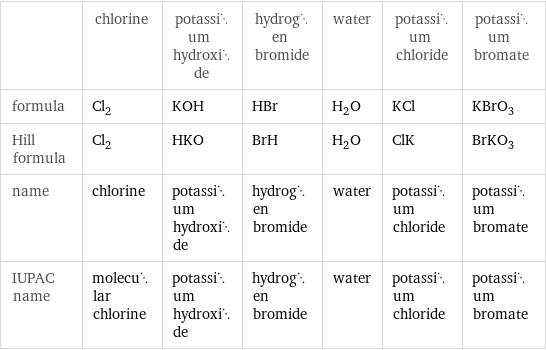
| chlorine | potassium hydroxide | hydrogen bromide | water | potassium chloride | potassium bromate formula | Cl_2 | KOH | HBr | H_2O | KCl | KBrO_3 Hill formula | Cl_2 | HKO | BrH | H_2O | ClK | BrKO_3 name | chlorine | potassium hydroxide | hydrogen bromide | water | potassium chloride | potassium bromate IUPAC name | molecular chlorine | potassium hydroxide | hydrogen bromide | water | potassium chloride | potassium bromate
Substance properties
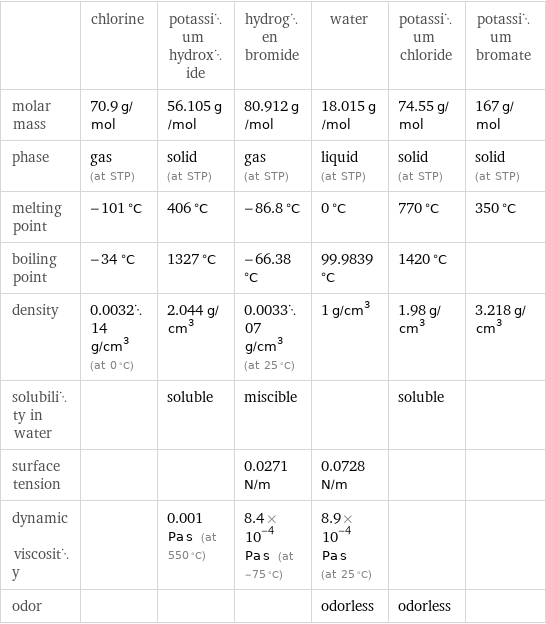
| chlorine | potassium hydroxide | hydrogen bromide | water | potassium chloride | potassium bromate molar mass | 70.9 g/mol | 56.105 g/mol | 80.912 g/mol | 18.015 g/mol | 74.55 g/mol | 167 g/mol phase | gas (at STP) | solid (at STP) | gas (at STP) | liquid (at STP) | solid (at STP) | solid (at STP) melting point | -101 °C | 406 °C | -86.8 °C | 0 °C | 770 °C | 350 °C boiling point | -34 °C | 1327 °C | -66.38 °C | 99.9839 °C | 1420 °C | density | 0.003214 g/cm^3 (at 0 °C) | 2.044 g/cm^3 | 0.003307 g/cm^3 (at 25 °C) | 1 g/cm^3 | 1.98 g/cm^3 | 3.218 g/cm^3 solubility in water | | soluble | miscible | | soluble | surface tension | | | 0.0271 N/m | 0.0728 N/m | | dynamic viscosity | | 0.001 Pa s (at 550 °C) | 8.4×10^-4 Pa s (at -75 °C) | 8.9×10^-4 Pa s (at 25 °C) | | odor | | | | odorless | odorless |
Units
